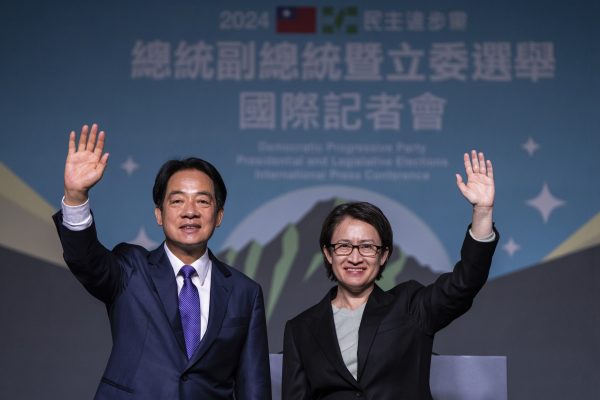Taiwanese Vice President Lai Ching-te, also known as William Lai, left, celebrates his victory with running mate Bi-khim Hsiao in Taipei, Taiwan, Jan. 13, 2024.
Credit: AP Photo/Louise Delmotte
At one point, many analysts and observers considered Taiwan’s 2024 presidential election dull. Just two months before election day, there were four presidential candidates, three of whom – Hou Yu-ih of the Kuomintang (KMT), Ko Wen-je of the Taiwan People’s Party (TPP), and independent Terry Gou, who had unsuccessfully sought the KMT nod – were all on the Blue end of Taiwan’s political spectrum. Democratic Progressive Party (DPP) candidate Lai Ching-te, also known as William Lai, was running unopposed representing the pan-Green camp.
With the opposition forces divided, Lai held a clear advantage for the majority of the summer months through the fall of 2023. For all intents and purposes, he was poised to coast toward victory.
That said, the later stage of the race brought unexpected drama. Beginning in late November, the potential for the opposition to settle on a unity ticket to run against Lai finally fell apart in one of the most spectacular press conferences in Taiwan’s history. Hou, Ko, and Gou repeatedly needled each other on live television.
In the end Taiwan ended up with three tickets: Lai and Hsiao Bi-khim of the DPP, Hou and Jaw Shao-kong of the KMT, and Ko and Cynthia Wu of the TPP. Unlike previous presidential elections, campaigning with full tickets only lasted a little over a month. In that time, candidates did their best to fight, sway, and win over Taiwanese voters.
What was this election about? For the DPP and KMT, this was a classic Taiwanese presidential election: It was about China, and who could keep Taiwan safe. The frame of “war versus peace” featured heavily in the KMT’s campaign slogans and rhetoric, while the DPP spoke of the election as a choice between “democracy and autocracy.” For these two parties, this approach made sense; decades of public opinion research demonstrates that for the majority of Taiwanese voters, it is China and cross-strait issues that matter the most when it comes time to vote for presidents.
But for Ko, the face of a young political party, China was not the top issue (although it was an issue). Ko’s campaign rhetoric was focused on two things: opposing the DPP and the KMT, and appealing to social issues. Ko and his populist appeal attracted many Taiwanese voters, especially younger voters, who do not see China as an existential issue in the same way that the DPP and KMT do. Ko was able to campaign on being anti-establishment, claiming he would improve wages, housing, and other domestic related problems, and focused less on China.


